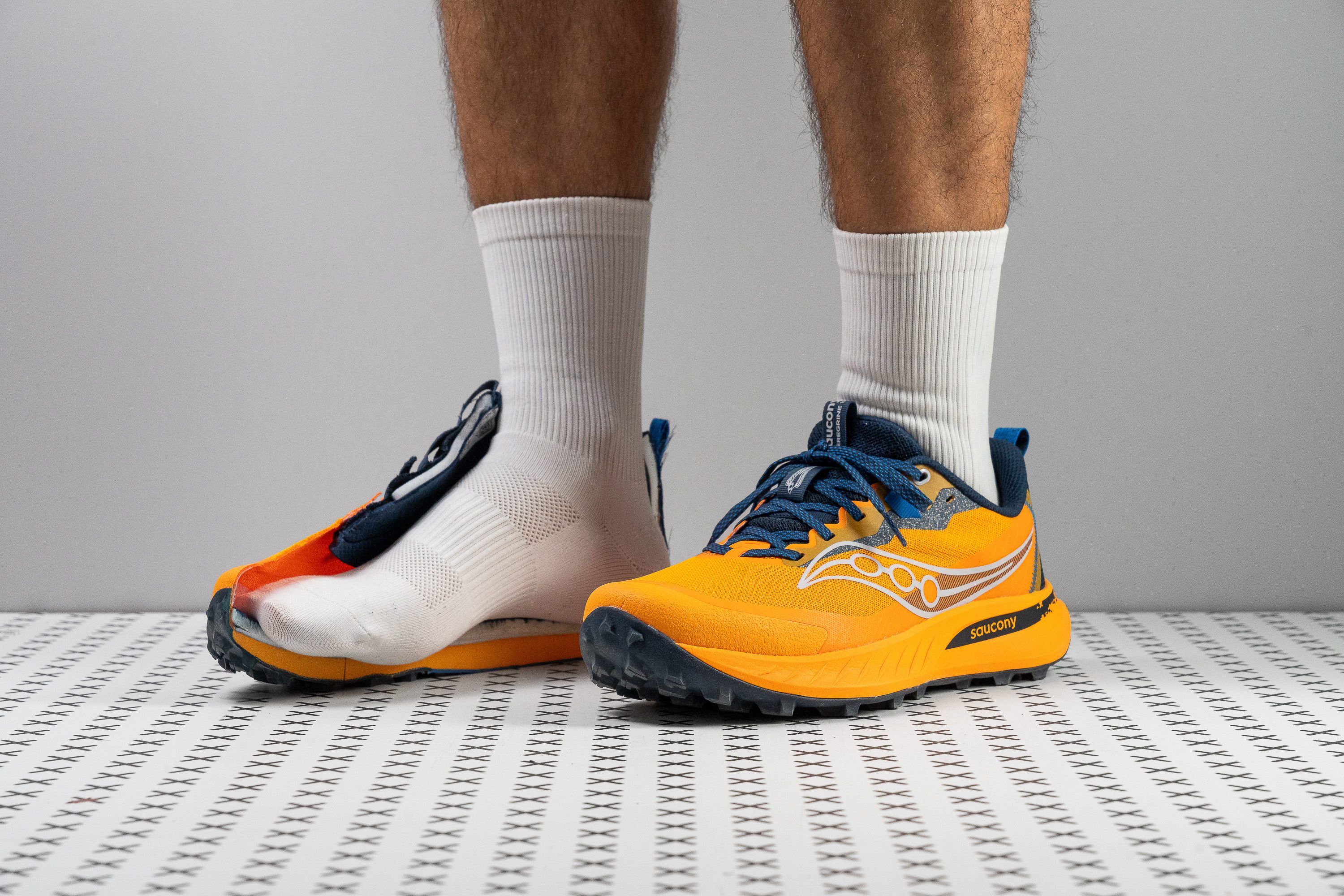Nuestra conclusión
Pros
- Mediasuela PWRRUN mullida
- Retorno de energía mejorado
- Tacos versátiles de 4,7 mm
- Preparadas para hacer senderismo
- Precio razonable
- Plantilla de PWRRUN+ de primera calidad
- Buen ajuste para el trail running
- Ligeras para su tamaño
Contras
- Parte delantera estrecha
- El drop bajo no es ideal para los talonadores
- Podrían ser más transpirables
Veredicto de los usuarios
Comparativa
Las zapatillas de running más parecidas
+ + Añadir unas zapatillas | |||||
|---|---|---|---|---|---|
| Puntuación global | 77 Aceptables | 77 Aceptables | 89 Notables | 90 Excelentes | |
| Precio | 150 € | 160 € | 140 € | 150 € | |
| Terreno de trail | SencilloModerado | SencilloModerado | ModeradoTécnico | ModeradoTécnico | |
| Absorción de impactos | Moderada | Moderada | Baja | - | |
| Retorno de energía | Moderado | Moderado | Bajo | - | |
| Tracción | - | Alta | - | - | |
| Arch support | Neutral | Neutral | Neutral | Neutral | |
| Peso laboratorio Peso marca | 9.4 oz / 266g 9.7 oz / 275g | 9.2 oz / 261g 9.3 oz / 263g | 9.6 oz / 271g 10.2 oz / 290g | 10.2 oz / 288g 10.1 oz / 286g | |
| Drop laboratorio Drop marca | 3.7 mm 4.0 mm | 3.7 mm 5.0 mm | 3.0 mm 4.0 mm | 4.4 mm 3.0 mm | |
| Técnica de carrera | Medio/antepié | Medio/antepié | Medio/antepié | Medio/antepié | |
| Talla | Tallan bien | Tallan bien | Tallan bien | Tallan bien | |
| Rigidez de la mediasuela | Blanda | Blanda | Blanda | Blanda | |
| Diferencia de la rigidez de la mediasuela en frío | Pequeña | Grande | Normal | Normal | |
| Placa | Rock plate | Rock plate | ✗ | ✗ | |
| Durabilidad de la parte delantera | Buena | Muy buena | Buena | Muy buena | |
| Durabilidad del acolchado del talón | Media | Alta | Media | Media | |
| Durabilidad de la suela exterior | Buena | Buena | Buena | - | |
| Transpirabilidad | Media | Alta | Baja | Media | |
| Anchura / ajuste | Media | Media | Media | Media | |
| Anchura de la parte delantera | Estrecha | Ancha | Media | Media | |
| Flexibilidad | Moderada | Moderada | Moderada | Rígida | |
| Rigidez torsional | Flexibles | Flexibles | Rígidas | Moderadas | |
| Rigidez del contrafuerte del talón | Moderado | Moderado | Flexible | Moderado | |
| Profundidad del dibujo de la suela | 4.7 mm | 3.3 mm | 4.0 mm | 4.4 mm | |
| Altura de la suela en la zona del talón laboratorio Altura de la suela en la zona del talón marca | 29.5 mm 28.0 mm | 28.3 mm 29.0 mm | 27.6 mm 31.0 mm | 30.1 mm 31.0 mm | |
| Antepié laboratorio Antepié marca | 25.8 mm 24.0 mm | 24.6 mm 24.0 mm | 24.6 mm 27.0 mm | 25.7 mm 28.0 mm | |
| Anchuras disponibles | EstándarAncho | Estándar | Estándar | Estándar | |
| Estación | Todas las estaciones | VeranoTodas las estaciones | Invierno | Todas las estaciones | |
| Removable insole | ✓ | ✓ | ✓ | ✓ | |
| Orthotic friendly | ✓ | ✓ | ✓ | ✓ | |
| Clasificación | #331 11% inferior | #334 10% inferior | #97 Top 27% | #37 Top 10% | |
| Popularidad | #128 Top 35% | #262 29% inferior | #221 40% inferior | #300 19% inferior |
Quién debería comprárselas
Después de hacerles montones de pruebas tanto fuera como dentro de nuestro laboratorio, creemos que las ds Saucony Peregrine 15 son ideales para:
- Los corredores que están buscando unas zapatillas de trail sencillas con un drop bajo y un precio justo.
- Los que estén buscando unas zapatillas de trail para todo: desde caminos sencillos hasta zonas rocosas.
- Los fans de las Peregrine que están listos para una actualización. Esta tiene una mediasuela más blandita y mejoras bien pensadas, ¡y sin ser más cara!
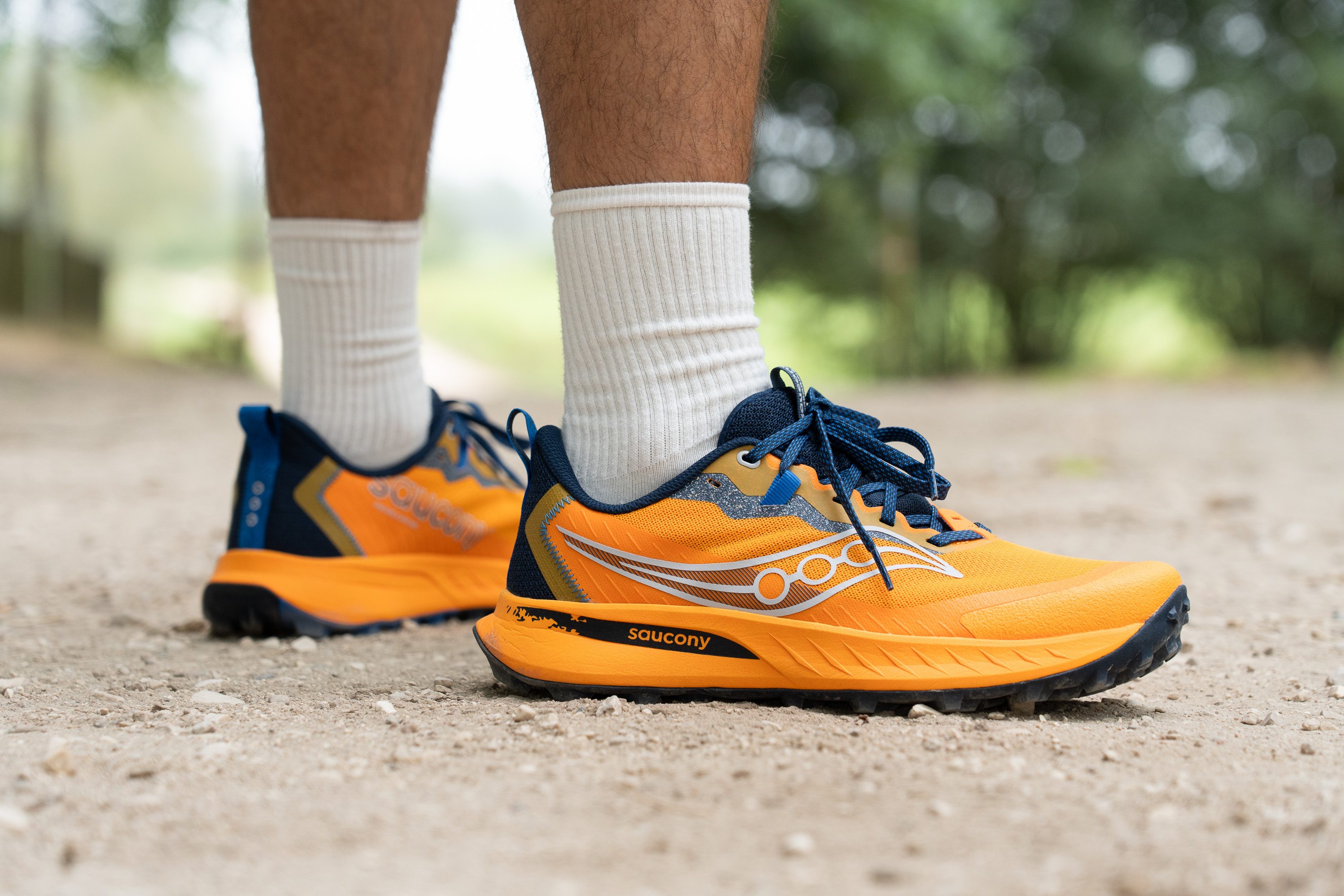
Quién NO debería comprárselas
Creemos que el mayor inconveniente de las Peregrine 15 es su parte delantera estrecha y puntiaguda. En nuestra experiencia, esto puede convertirse en un problema si corres varias horas seguidas, sobre todo para los corredores que tienen pies anchos o para los que son propensos a tener molestias en los dedos. Si prefieres un ajuste más espacioso y que siga la forma del pie, te recomendamos las Topo Ultraventure 4 o las Altra Lone Peak 9 (estas últimas tienen drop cero).
También estamos convencidos de que el drop de 4 mm de este modelo no es la mejor opción para los talonadores extremos. Si eres uno de ellos, probablemente otras opciones como las ASICS Gel Trabuco 13 o las Nike Wildhorse 10 te gusten más.

Amortiguación
Shock absorption
Cuando analizamos la absorción de impactos de las Peregrine 15, nuestra máquina marcó 125 SA. Este resultado nos tiene todo el sentido del mundo, ya que están lejos de ser unas zapatillas de trail maximalistas. Están más bien cerca de la media, ofreciendo la amortiguación justa sin sacrificar el contacto con el suelo.

| Peregrine 15 | 125 SA |
| Media | 122 SA |
Energy return
Cuando analizamos el retorno de energía de estas zapatillas, nuestra máquina marco un 60,4 % en el talón y un 65,8 % en el antepié. Ambos resultados son superiores a la media, y son muy buenas noticias para los corredores que están buscando una pisada reactiva. De esta combinación de rebote y un buen precio han nacido las Peregrine 15, unas de las zapatillas de trail con el mejor rendimiento.
| Peregrine 15 | 60.4% |
| Media | 55.6% |
Altura de la suela en la zona del talón
Es impresionante la cantidad de absorción de impactos que ofrece este modelo con una suela de solo 29,5 mm de altura. En un mercado lleno de zapatillas de trail nuevas con suelas que se acercan a los 40 mm, estas nos parecen una elección perfecta para los corredores más ligeros que no necesitan un talón gigantesco.
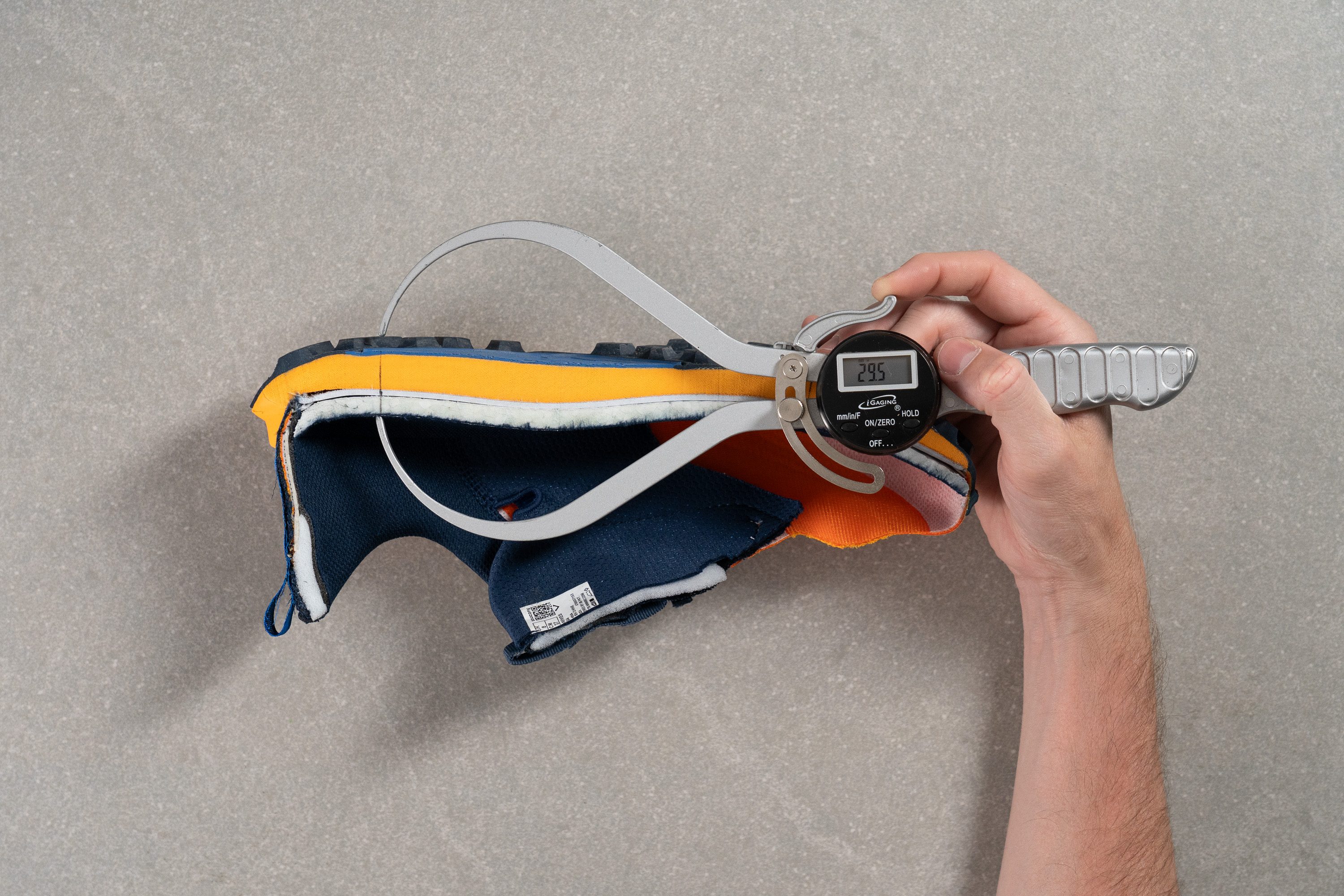
| Peregrine 15 | 29.5 mm |
| Media | 32.6 mm |
Altura de la suela en el antepié
El antepié ofrece mucha amortiguación para adaptarse bien a la mayoría de las distancias y, como puedes ver, su altura se parece bastante a la del talón. Gracias a nuestro calibre, vimos que alcanzaba 25,8 mm.
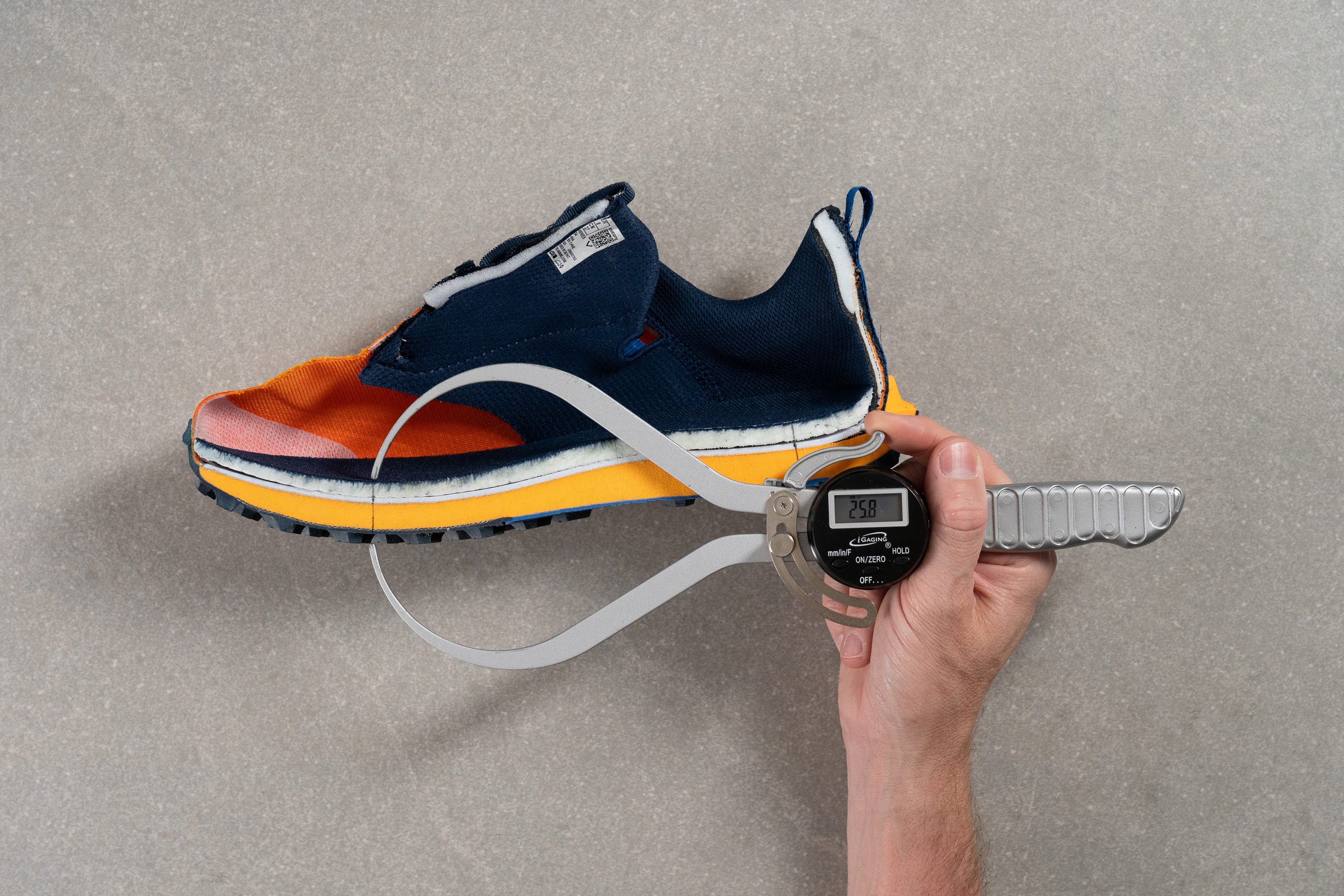
| Peregrine 15 | 25.8 mm |
| Media | 25.1 mm |
Drop
Una característica destacada que analizamos en las Peregrine 15 fue su diseño de drop bajo, que es algo que no solemos ver en los modelos de trail de las marcas más populares.
La diferencia entre el talón y el antepié es de solo 3,7 mm, lo que hace que este modelo sea una opción ideal para los corredores de metatarsos o de mediopié. A lo mejor a los talonadores también disfrutan de la pisada de estas Saucony, pero a los que aterrizan con más fuerza probablemente no les parezcan tan fluidas como otra opción con un drop más alto.
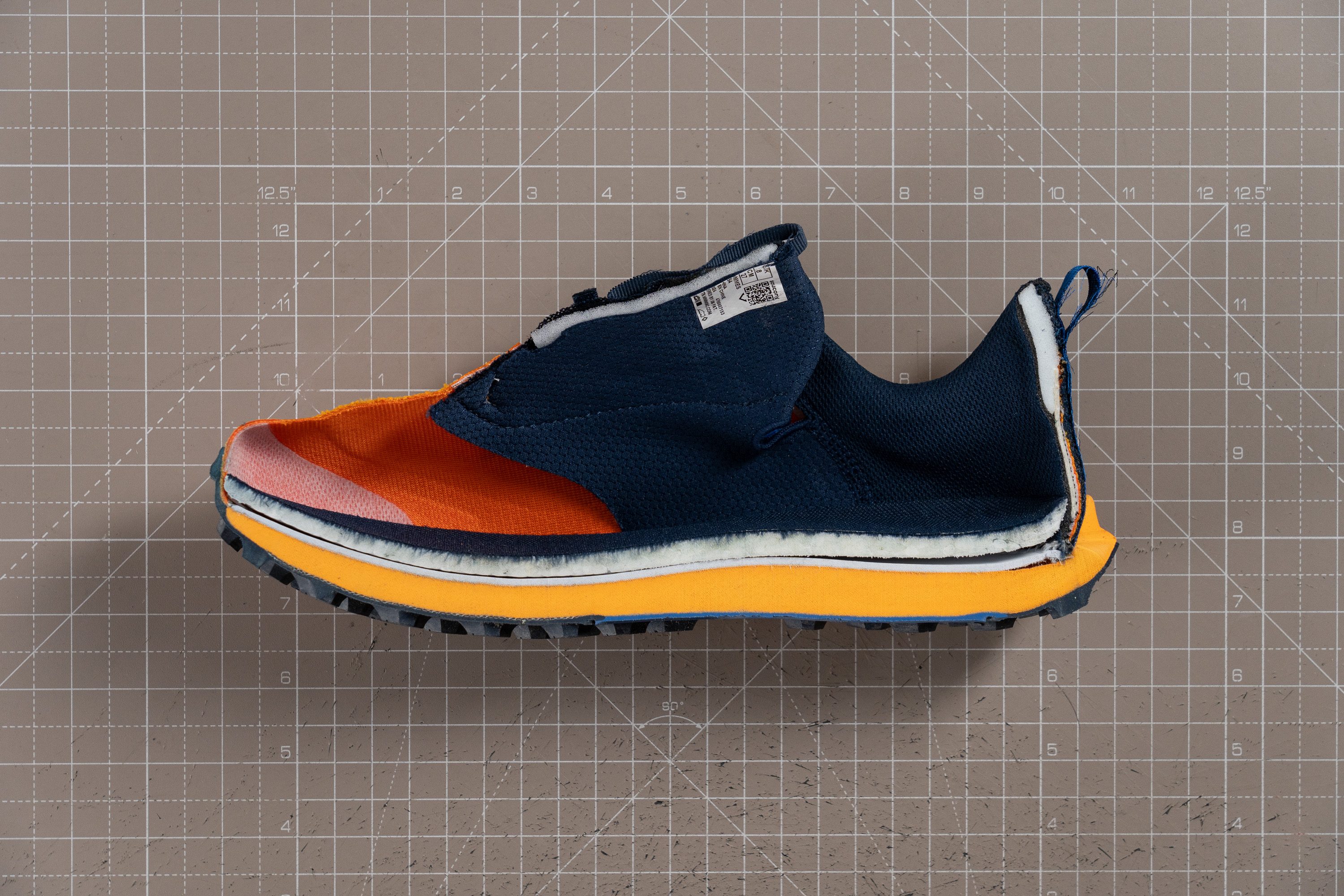
| Peregrine 15 | 3.7 mm |
| Media | 7.5 mm |
Suavidad de la mediasuela
El año pasado descubrimos que las Peregrine 14 se sentían demasiado rígidas bajo los pies. Pero esta vez Saucony decidió tomar una ruta distinta, utilizando una espuma PWRRUN mucho más blandita. Cuando la analizamos, nuestro durómetro marcó 14,9 HA, cuando el moldelo anterior había obtenido un resultado de 26,0 HA en esta misma prueba. Por lo tanto, el cambio no está nada mal, ya que la diferencia es del 42 %.
Esta actualización hace que la pisada sea bastante más blandita y cómoda para las piernas. Las personas que prefieran una sensación firme y estable pueden echarle un ojo a la versión anterior (que además seguro que la encuentran rebajada) pero, para todos los demás, esta nueva mediasuela hace que la experiencia sea más cómoda.
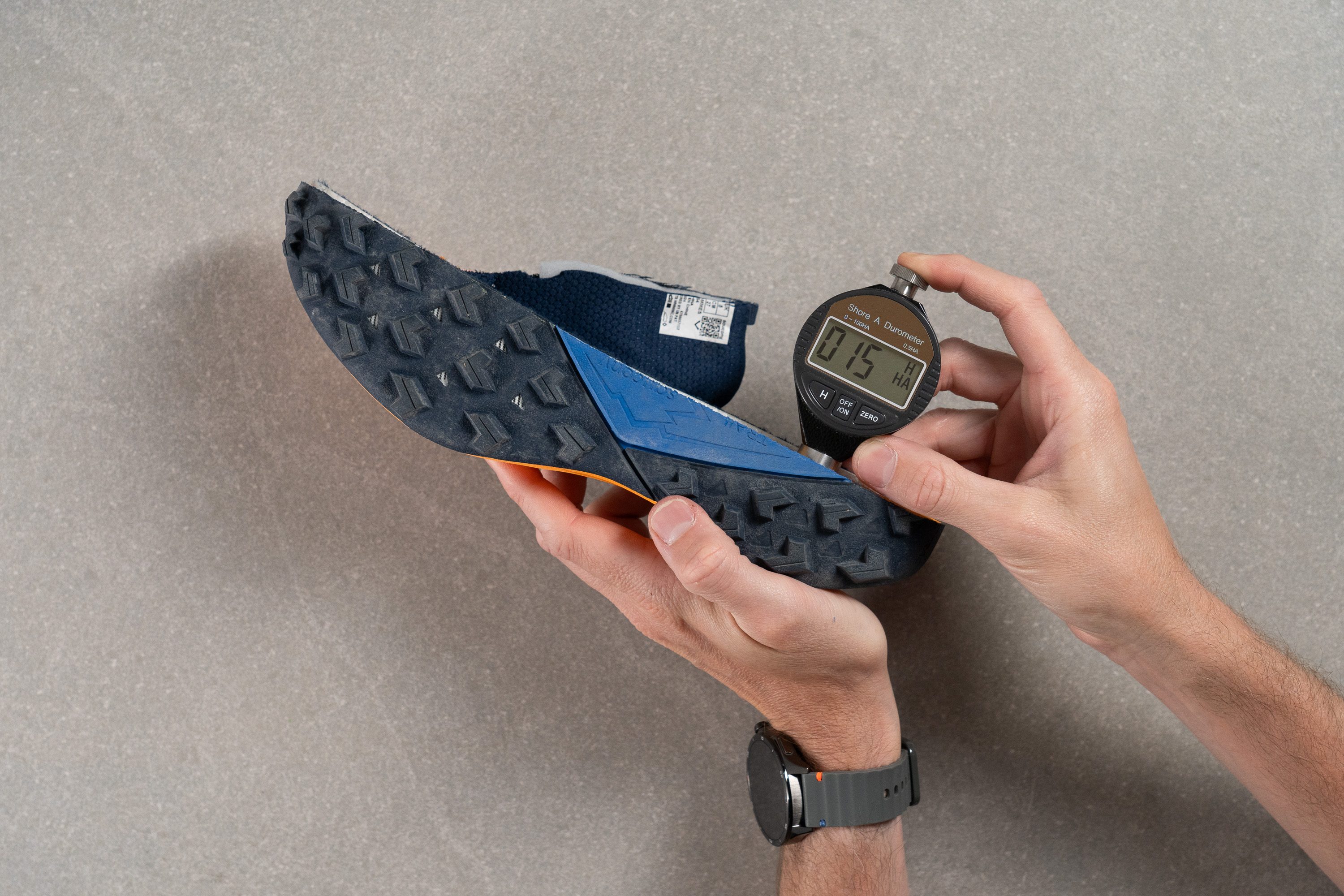
| Peregrine 15 | 14.9 HA |
| Media | 21.9 HA |
Rocker
Las Peregrine 15 utilizan el rocker Speedroll de Saucony para que las transiciones sean suaves y empujarte hacia adelante. Aunque no es tan agresivo como el de los modelos para correr por asfalto, hace que la sensación sea natural, lo que les viene incluso mejor a los talonadores.

Placa
Descubrimos que las Peregrine 15 tienen una placa anti rocas de plástico que está solo en el antepié, y se puede ver a través de los cortecitos que hay en esa zona. Básicamente, es una pieza de plástico liviana que proporciona protección donde más importa, y es especialmente útil para los corredores que se enfrentan a senderos rocosos.
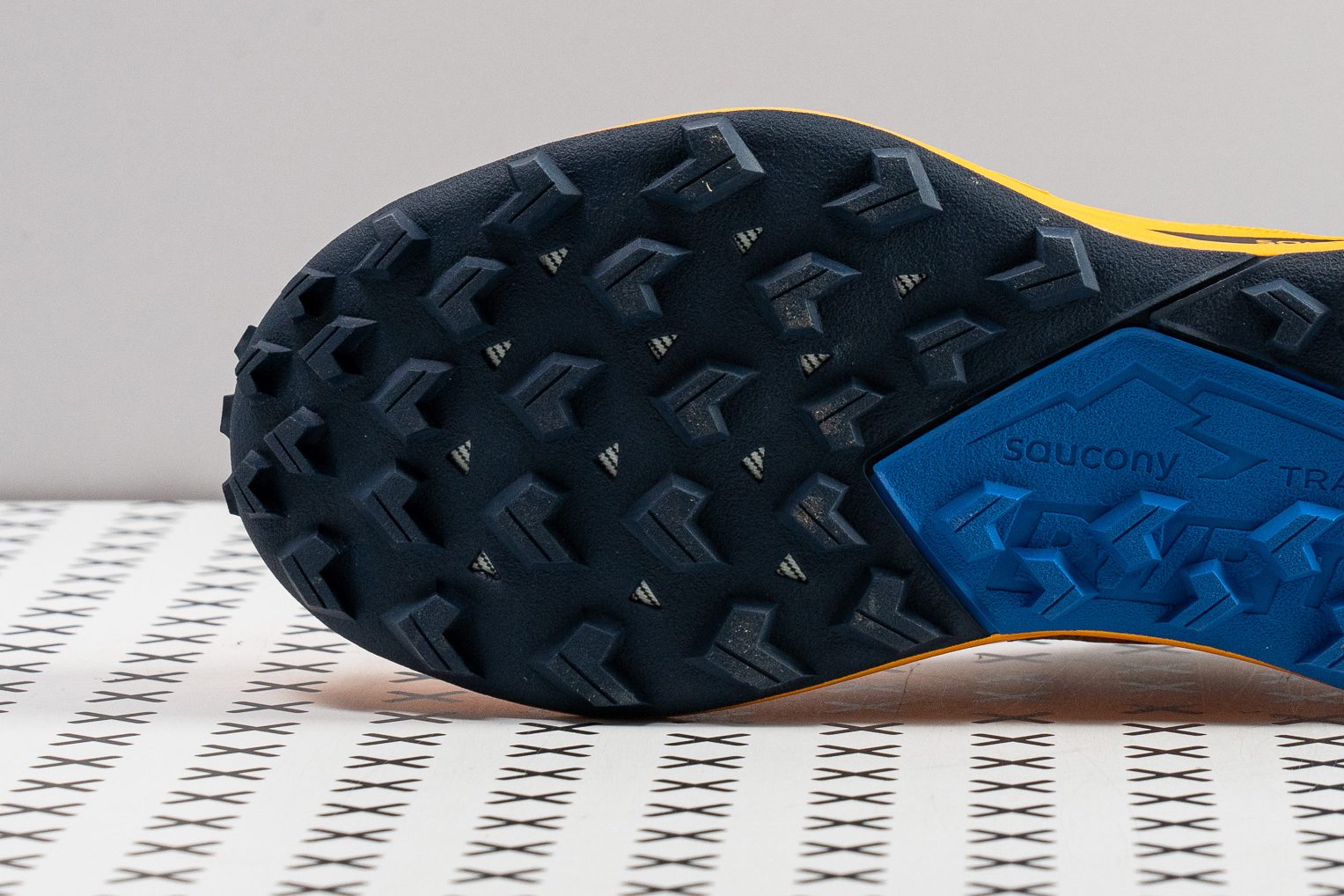
Tallaje y ajuste
Talla
Las Saucony Peregrine 15 tallan bien (18 votos).
Anchura / Ajuste
El ajuste de las Peregrine 15 es parecido al de las versiones anteriores, y te lo podemos decir de primera mano porque les hicimos pruebas de uso (igual que a todas las zapatillas que pasan por nuestras manos). Pero bueno, que incluso con toda esta información, nos gusta medir las cosas con precisión (vaya pareado). Para conseguirlo, primero hicimos un molde de gel de estas Saucony y luego cogimos nuestro calibre, que marcó una anchura de 95,5 mm.
Eso hace que estén en la media si las comparamos con otras zapatillas de trail running.
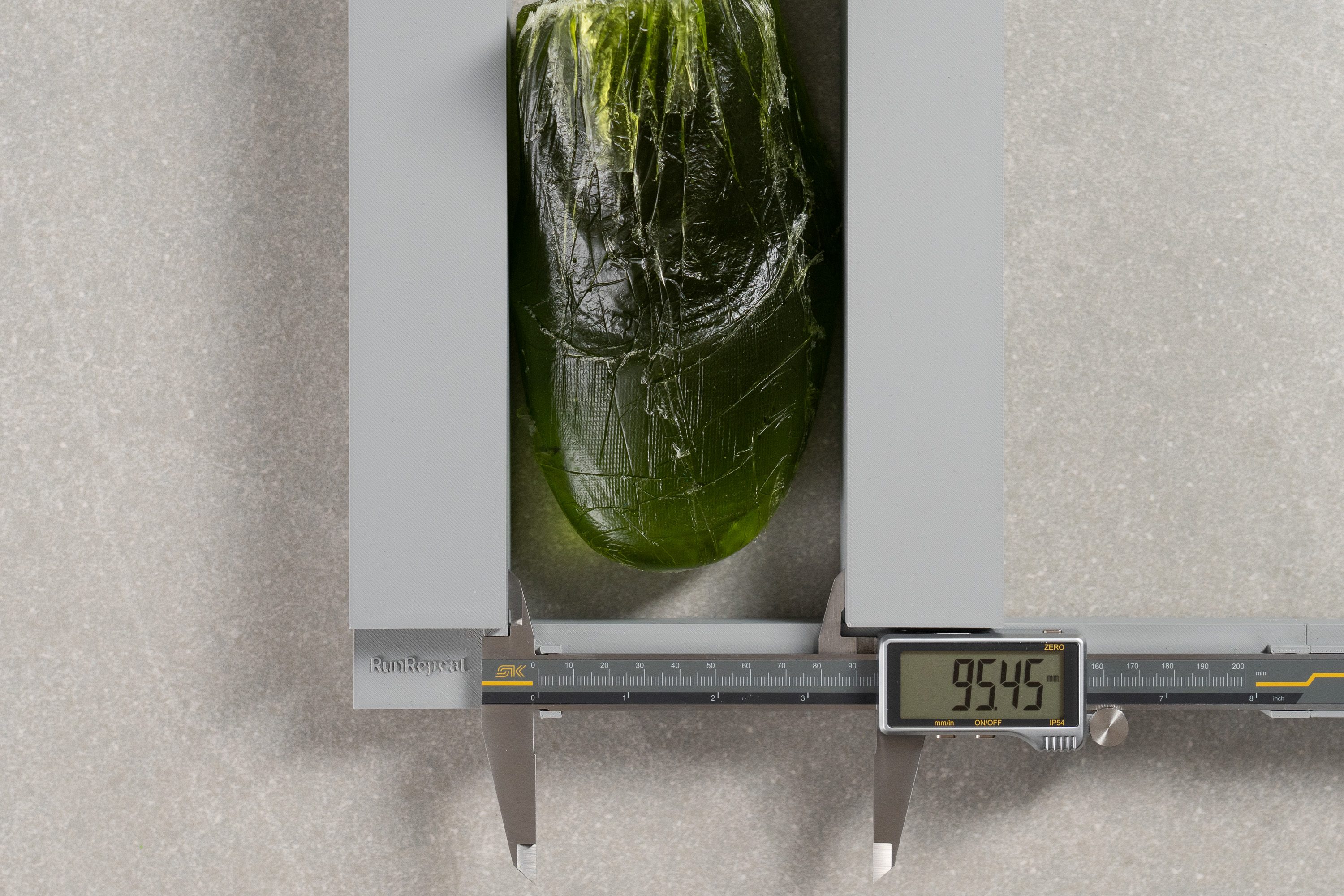
| Peregrine 15 | 95.5 mm |
| Media | 95.7 mm |
Anchura de la parte delantera
Volvimos a medir el molde, y es que esta segunda medición es clave para entender el ajuste de las Peregrine 15. Saucony mantuvo la misma forma estrecha que vimos en las 14, con solo 70,9 mm de ancho en la parte delantera.
Es un diseño estrecho, así que no es la mejor opción para los corredores con pies anchos que están buscando un espacio extra en la parte delantera.
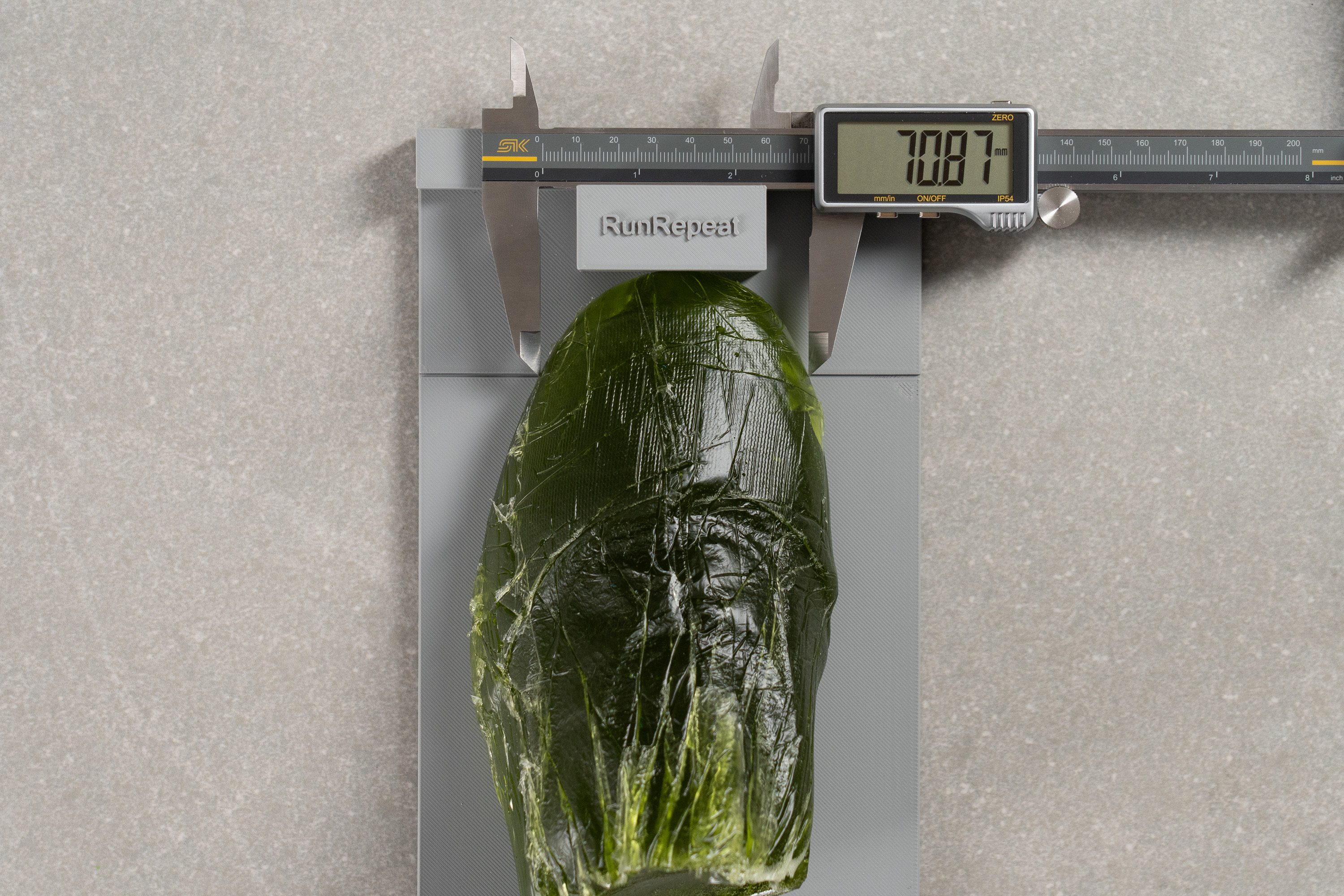
| Peregrine 15 | 70.9 mm |
| Media | 74.7 mm |
Altura de la parte delantera
En contraste con lo estrecha que es la parte delantera, su altura es bastante generosa, de 28,2 mm.
Este espacio vertical extra deja que tus dedos respiren, lo que hace que este modelo sea ideal para las aventuras largas en el trail.
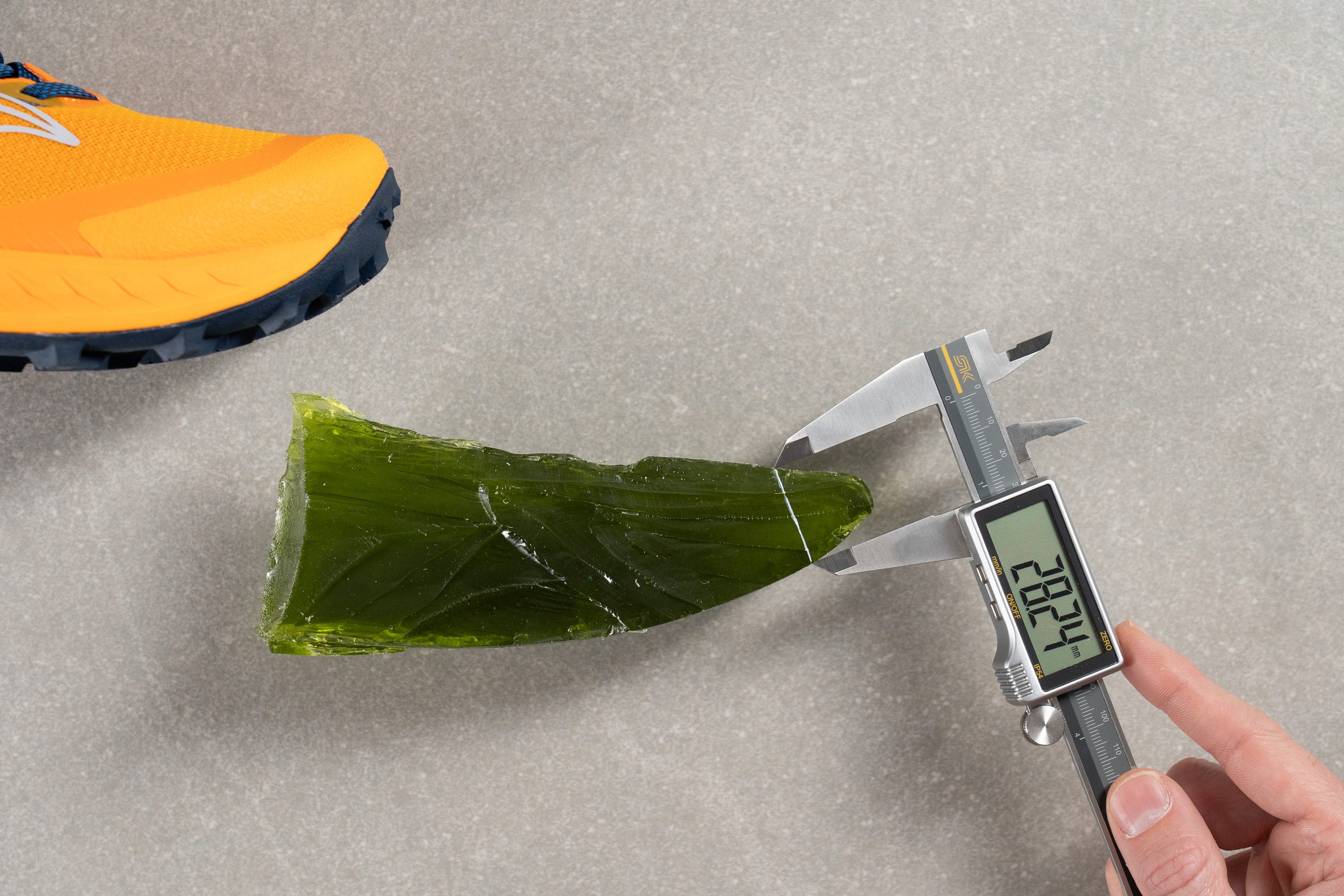
| Peregrine 15 | 28.2 mm |
| Media | 27.1 mm |
Tracción / Agarre
Profundidad del dibujo de la suela
Las Peregrine se mantienen fieles a sus raíces con sus tacos agresivos. Aunque hubiera sido tentador para Saucony reducirlos a 3 o 3,5 mm para mejorar la versatilidad, la marca optó por no cambiar su diseño en forma de V de 4,7 mm.
La verdad es que estamos muy contentos con esta decisión. Muchas zapatillas de trail nuevas tienen tacos pequeños, pero las Peregrine han conseguido adaptarse mejor a todo tipo de terrenos.

| Peregrine 15 | 4.7 mm |
| Media | 3.5 mm |
Diseño de la suela exterior
La suela de las Saucony Peregrine 15 está hecha con un compuesto de caucho PWRTRAC de longitud completa de dos colores que crean contraste, y tiene una clara segmentación entre la parte delantera y la trasera.
Tiene 31 tacos colocados en direcciones alternas, utilizando patrones orientados hacia atrás en el talón para el frenado y hacia adelante en el antepié para facilitar el impulso y la escalada.

Flexibilidad / Rigidez
Teniendo en cuenta lo altas que son y que toda su suela está cubierta de caucho, la flexibilidad de las Peregrine 15 consiguió dejarnos boquiabiertos. Solo necesitaron 11,1 N para doblarse en nuestra prueba de laboratorio, que es un resultado más bajo que la media, confirmado así lo flexible que es su estructura.
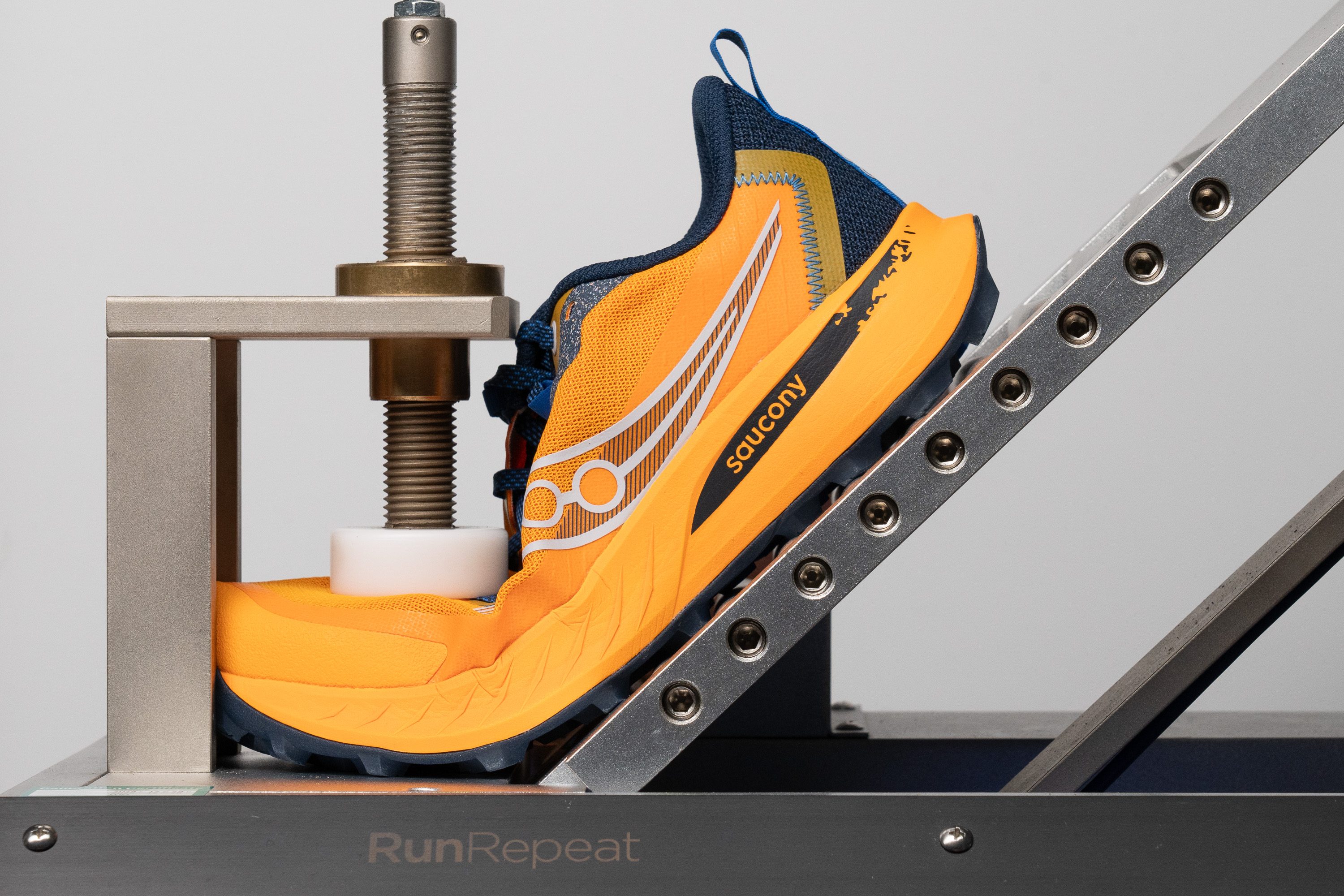
| Peregrine 15 | 11.1N |
| Media | 14.6N |
Peso
Las Peregrine 15 se han llevado otra victoria, ya que han conseguido mantener exactamente el mismo peso que sus predecesoras: 266 g. Las pesamos a la vez y no vimos ningún cambio en la báscula.
La verdad es que es impresionante. De hecho, es uno de los poquísimos modelos de trail que consigue ser muy cómodo sin añadir mucho peso.

| Peregrine 15 | 9.4 oz (266g) |
| Media | 10.2 oz (289g) |
Transpirabilidad
A primera vista, el upper de las Peregrine 15 parece resistente y listo para el trail; así como si estuviese diseñado para las aventuras duras y no tanto para dejar que tus pies respiren. Pero bueno, incluso después de este análisis visual, encendimos nuestra máquina de humo y cogimos la pieza que hemos diseñado nosotros mismos con una impresora 3D para dirigir el humo a la parte delantera de las zapatillas. Así podemos ver sin ningún problema si deja que el aire caliente salga o si lo retiene en su estructura.
Una vez terminó esta prueba, decidimos darles un 3/5 en transpirabilidad a las Peregrine. Es un resultado sólido para unas zapatillas de trail que sugiere que son cómodas durante todo el año. Si sales con ellas en verano, te recomendamos que te las pongas con calcetines finitos que absorban bien la humedad para que tus pies estén fresquitos y secos.
Después analizamos el upper con nuestra luz para saber más sobre él. Está claro que Saucony optó por un diseño estructurado que se centra en la sujeción tanto en el talón como en el mediopié, y la parte delantera es la única que se centra en la transpirabilidad.
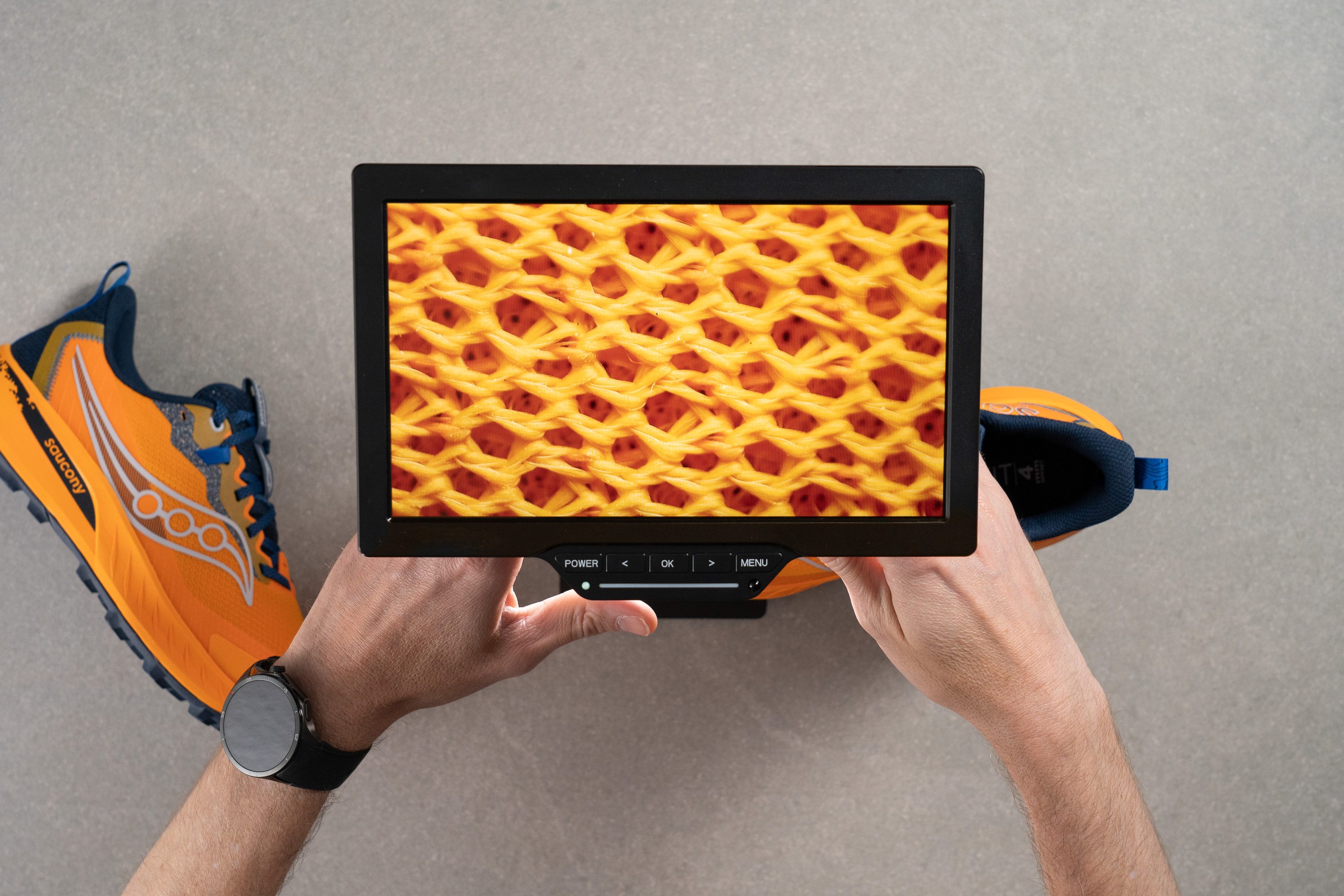
Bajo el microscopio, descubrimos que la malla de este modelo no tiene nada del otro mundo, es normalita.
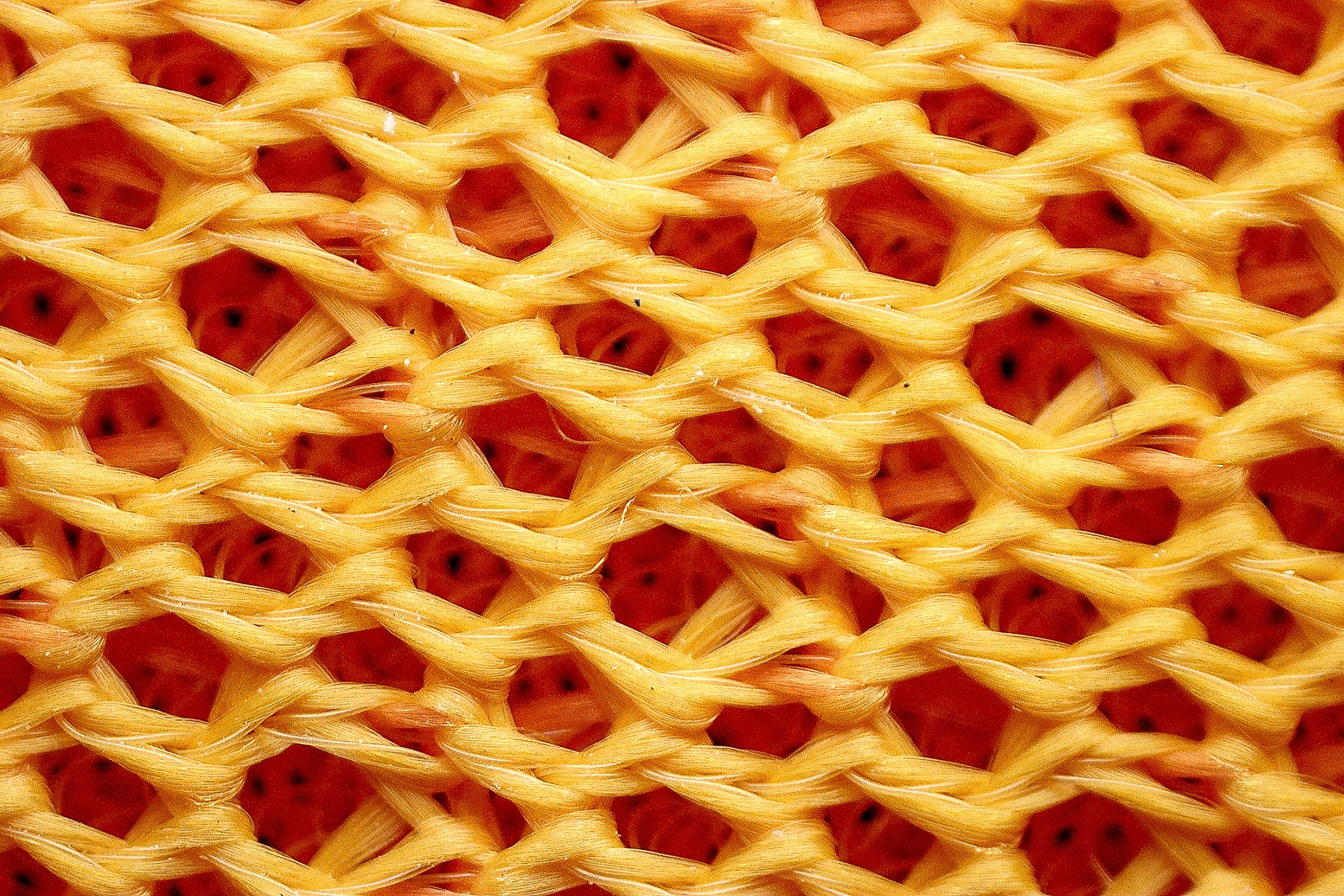
Hemos visto muchos diseños parecidos en el laboratorio, pero con esto no queremos decir que sea algo malo. Si algo funcioa bien, ¿para qué lo vas a cambiar?
Estamos encantados de que este upper combine comodidad y protección, y lo mejor de todo es que se inclina un poquito más hacia la durabilidad. Es un diseño sencillo y ya, que va totalmente de la mano con la identidad de estas zapatillas.
| Peregrine 15 | 3 |
| Media | 3.2 |
Estabilidad
Prueba de estabilidad lateral
Como las Peregrine 15 tienen una espuma más blandita, nos esperábamos que fuesen menos estables que la v14. Pero bueno, la verdad es que aguantan bastante bien en general.
Lo que sí que se ve un poquito afectada es la sujeción, pero no es nada que nos haga pensar que no nos compraríamos estas zapatillas. Es solo un pequeño sacrificio que la mayoría de los corredores entenderán.
Rigidez torsional
Al igual que en nuestra prueba de rigidez longitudinal, estamos encantados de poder decirte que Saucony no exageró con la rigidez. Las Peregrine 15 siguen siendo fáciles de doblar y de retorcer, ya que se llevaron un 2/5. Esto las hace más cómodas e ideales para hacer senderismo también.
| Peregrine 15 | 2 |
| Media | 3.6 |
Rigidez del contrafuerte del talón
El contrafuerte del talón se parece a lo que solemos ver en las zapatillas de entrenamiento diario para correr por asfalto, ya que se llevó un 3/5 en nuestra escala. Está estructurado, pero también bien acolchado y protegido, ofreciendo sujeción sin ser incómodo.
| Peregrine 15 | 3 |
| Media | 3 |
Anchura de la mediasuela - antepié
Aparte de la suave espuma PWRRUN, el mayor cambio en las Peregrine 15 con respecto a sus predecesoras son sus dimensiones. Ahora su parte delantera mide 117,0 mm, así que es bastante más ancha que la del modelo del año pasado, de 112,3 mm.
Esa anchura extra ayuda a explicar por qué, incluso con una espuma más blandita, estas zapatillas no se sintieron tan inestables como nos esperábamos.
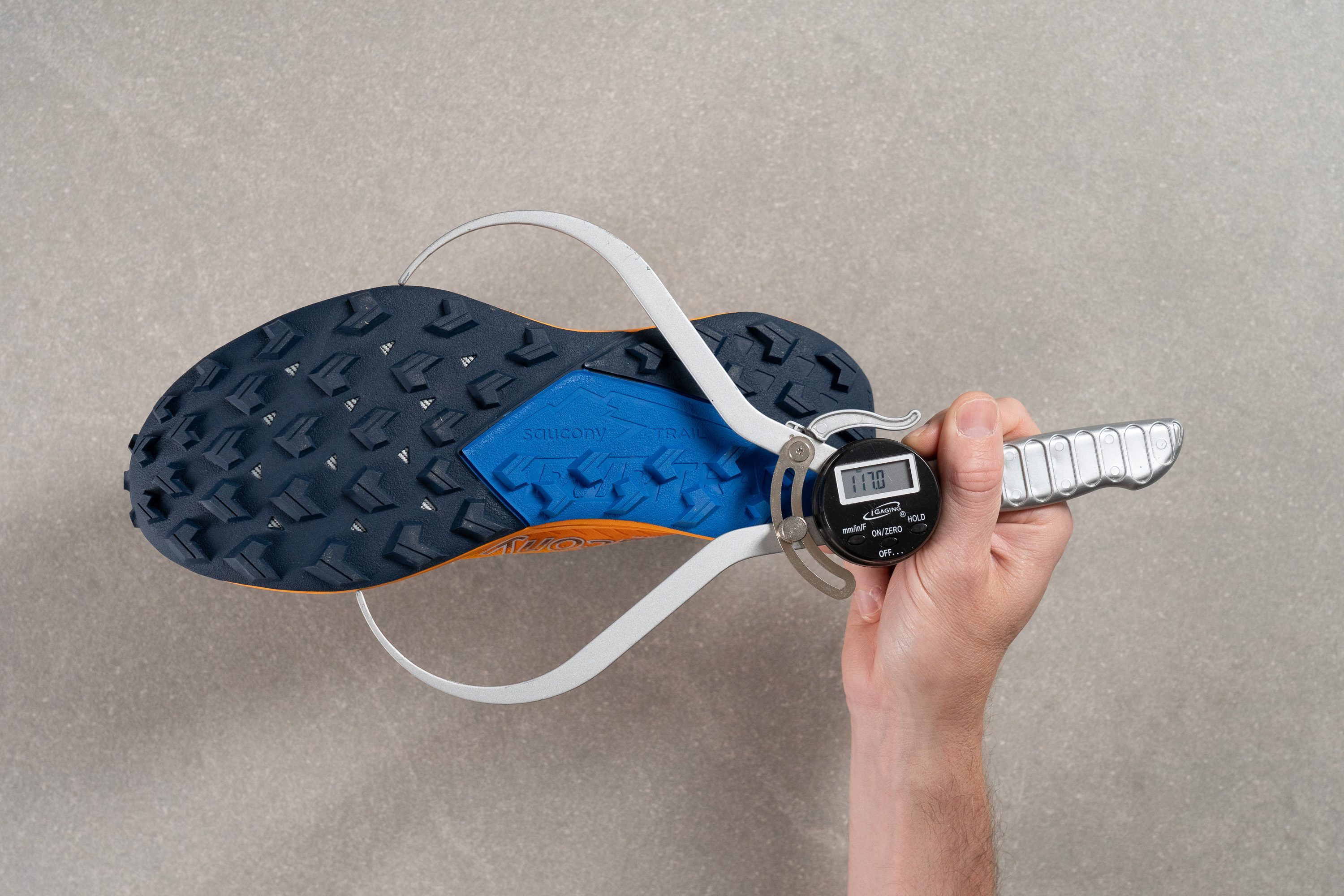
| Peregrine 15 | 117.0 mm |
| Media | 112.8 mm |
Anchura de la mediasuela - talón
Lo mismo pasa por el talón, que ha pasado de 85,9 mm a 90,5 mm en esta decimoquinta versión. A nosotros nos parece un cambio positivo, sobre todo para los talonadores que están buscando una plataforma aterrizaje más amplia.

| Peregrine 15 | 90.5 mm |
| Media | 89.9 mm |
Durabilidad
Durabilidad de la parte delantera
La durabilidad es un factor clave en cualquier modelo de trail running, así que nos temblaban las piernas nada más encender el Dremel. Cuando le dimos caña al upper, vimos que aguantó bien, asi que le dimos un merecido 4/5.
| Peregrine 15 | 4 |
| Media | 3.1 |
Durabilidad del acolchado del talón
El acolchado del talón también obtuvo una buena puntuación en nuestra prueba, aunque un 3/5 tampoco es nada loco. Pero bueno, nuestra conclusión es que la durabilidad no es uno de los puntos flojos de este modelo.
| Peregrine 15 | 3 |
| Media | 3 |
Durabilidad de la suela
La suela PWRTRAC también se tuvo que enfrentar a nuestro Dremel, y terminó con unos daños de 0,9 mm, que están dentro de la media de nuestro laboratorio. La verdad es que no es algo que nos parezca un problema, sobre todo teniendo en cuenta que este modelo tiene unos tacos profundos.
| Peregrine 15 | 0.9 mm |
| Media | 0.9 mm |
Grosor de la suela
La suela tiene solo 1,2 mm de grosor, probablemente para reducir el peso. Como las Peregrine 15 tienen una placa anti rocas, Saucony puede confiar en ella para la protección bajo los pies y utilizar menos caucho sin poner en riesgo la seguridad.

| Peregrine 15 | 1.2 mm |
| Media | 2.2 mm |
Varios
Grosor de la plantilla
Uno de los detalles ocultos en las Peregrine 15 es la plantilla, porque no es la mítica estándar que vemos en la mayoría de las zapatillas. Esta es más grandota, con 6,9 mm de grosor, y está hecha de PWRRUN+ a base de TPU en lugar de la EVA de siempre. Curiosamente, la espuma de la plantilla... en verdad es más premium que la propia mediasuela.
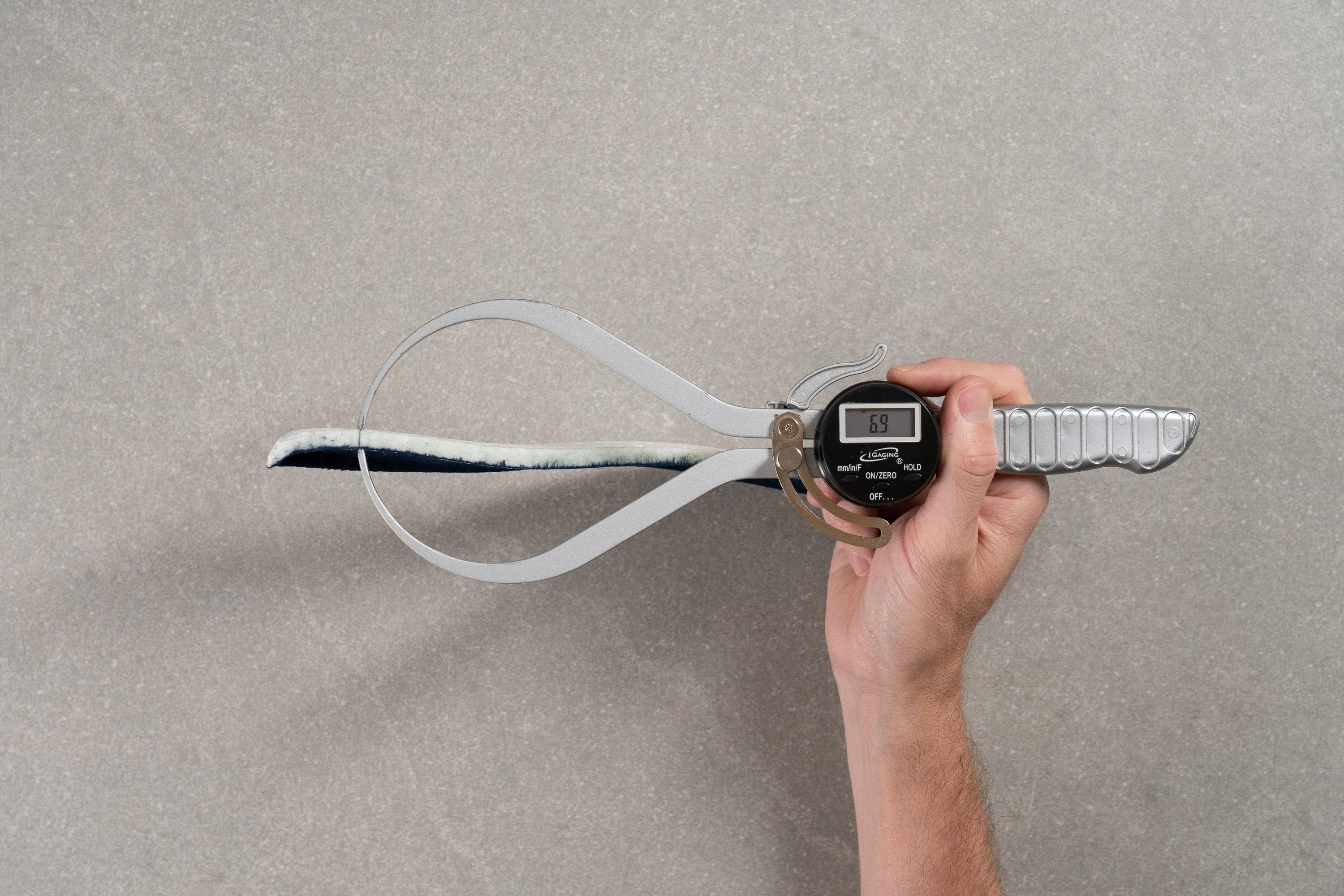
| Peregrine 15 | 6.9 mm |
| Media | 4.7 mm |
Plantilla extraíble
Si quieres utilizar tus propias plantillas o si prefieres una sensación más firme, siempre les puedes quitar la plantilla FormFit a estas Saucony. Pero claro, eso significa renunciar a una de las características más destacadas que tienen, ya que está hecha de PWRRUN+, como dijimos antes.
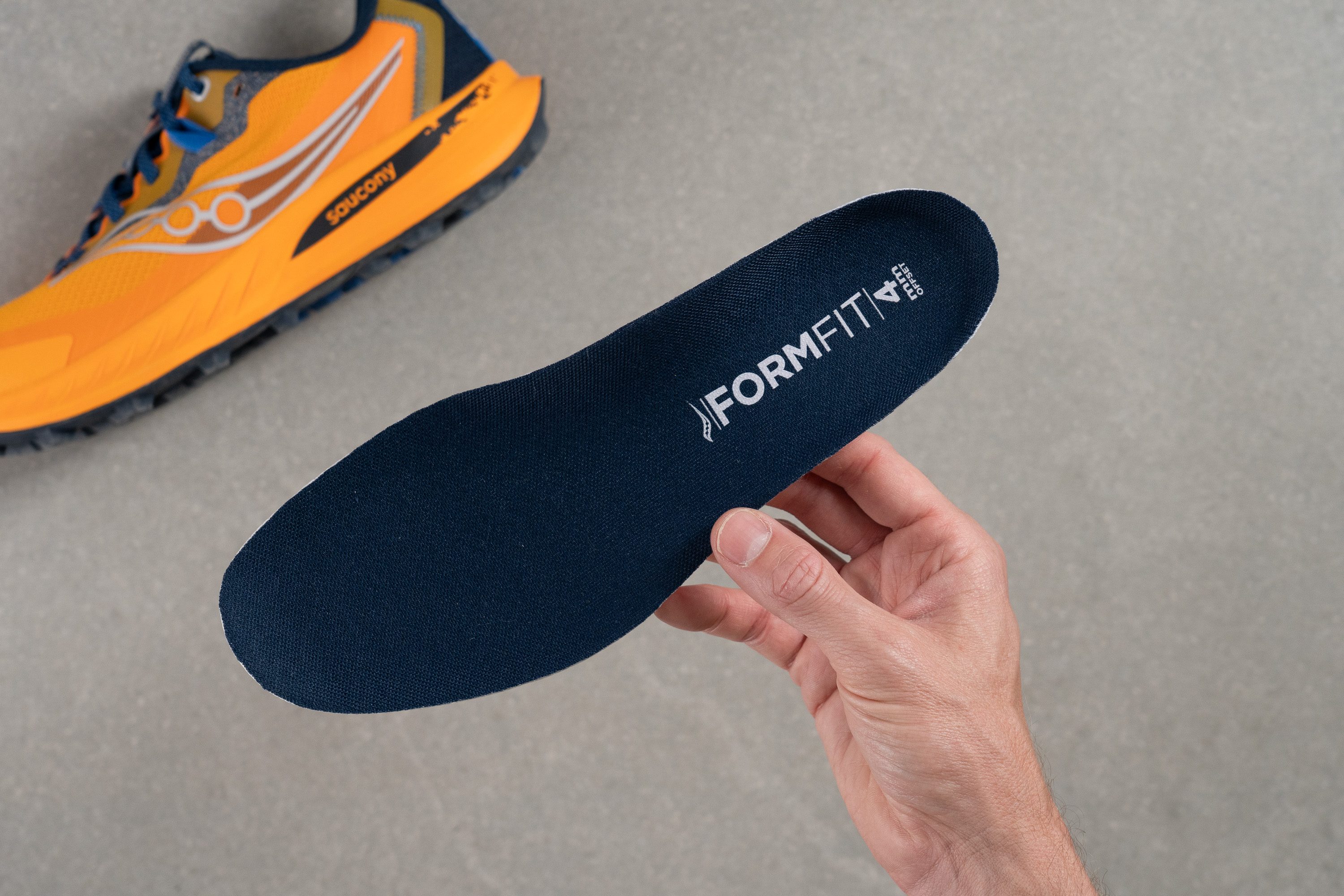
| Peregrine 15 | Sí |
Rigidez de la mediasuela en frío (%)
Metimos las Peregrine 15 en el congelador durante 20 minutos para ver qué tal llevan el frío. Solo se volvieron un 22 % más rígidas, que es un resultado bastante decente. Esto nos indica que resisten bien las bajas temperaturas.
| Peregrine 15 | 22% |
| Media | 26% |
Elementos reflectantes
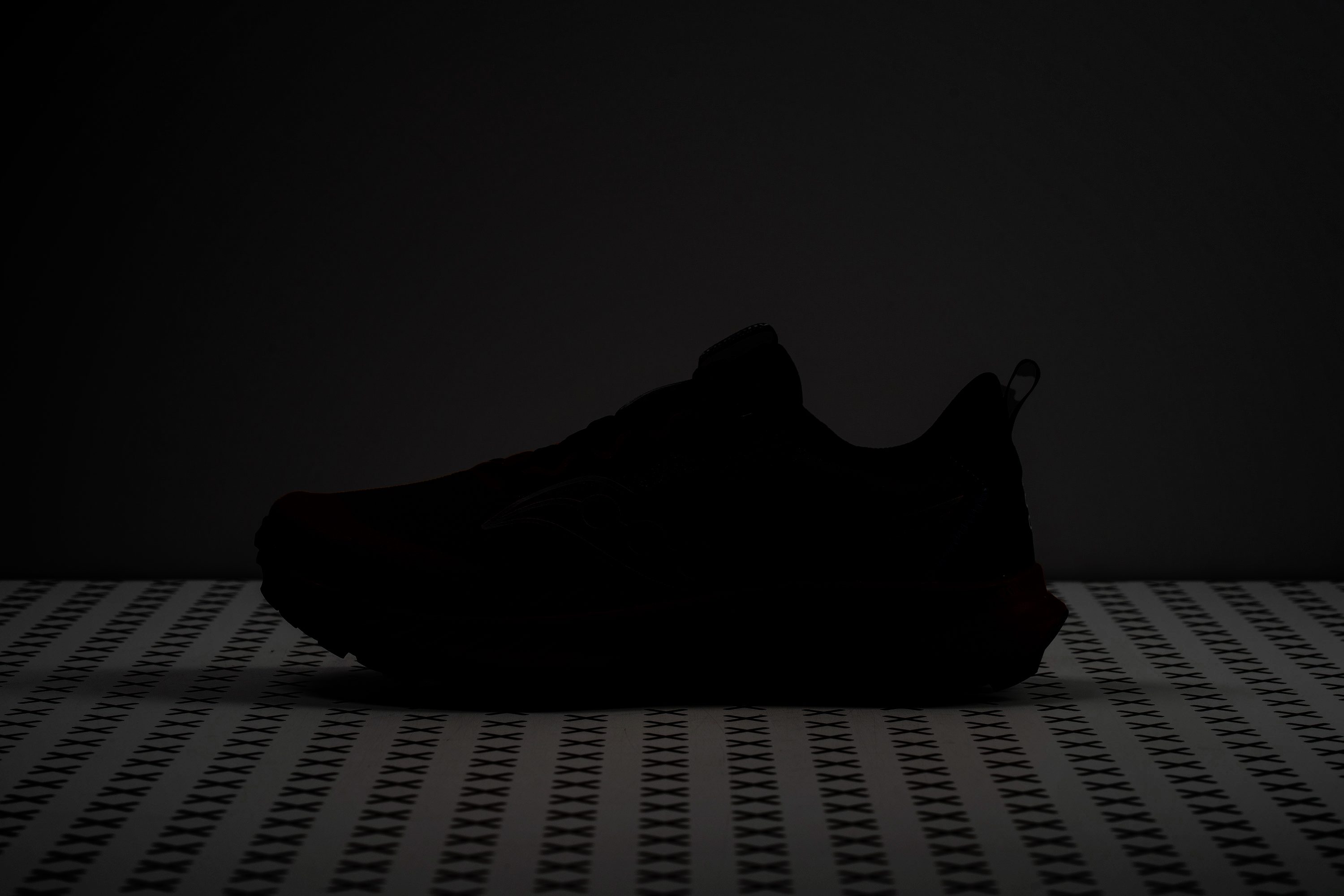
Acolchado de la lengüeta
La lengüeta de las Peregrine 15 tiene un grosor de 6,0 mm. Según nuestra experiencia, esto es suficiente incluso para las personas que se vana enfrentar a una ruta que dura todo el día o a un ultra maratón.
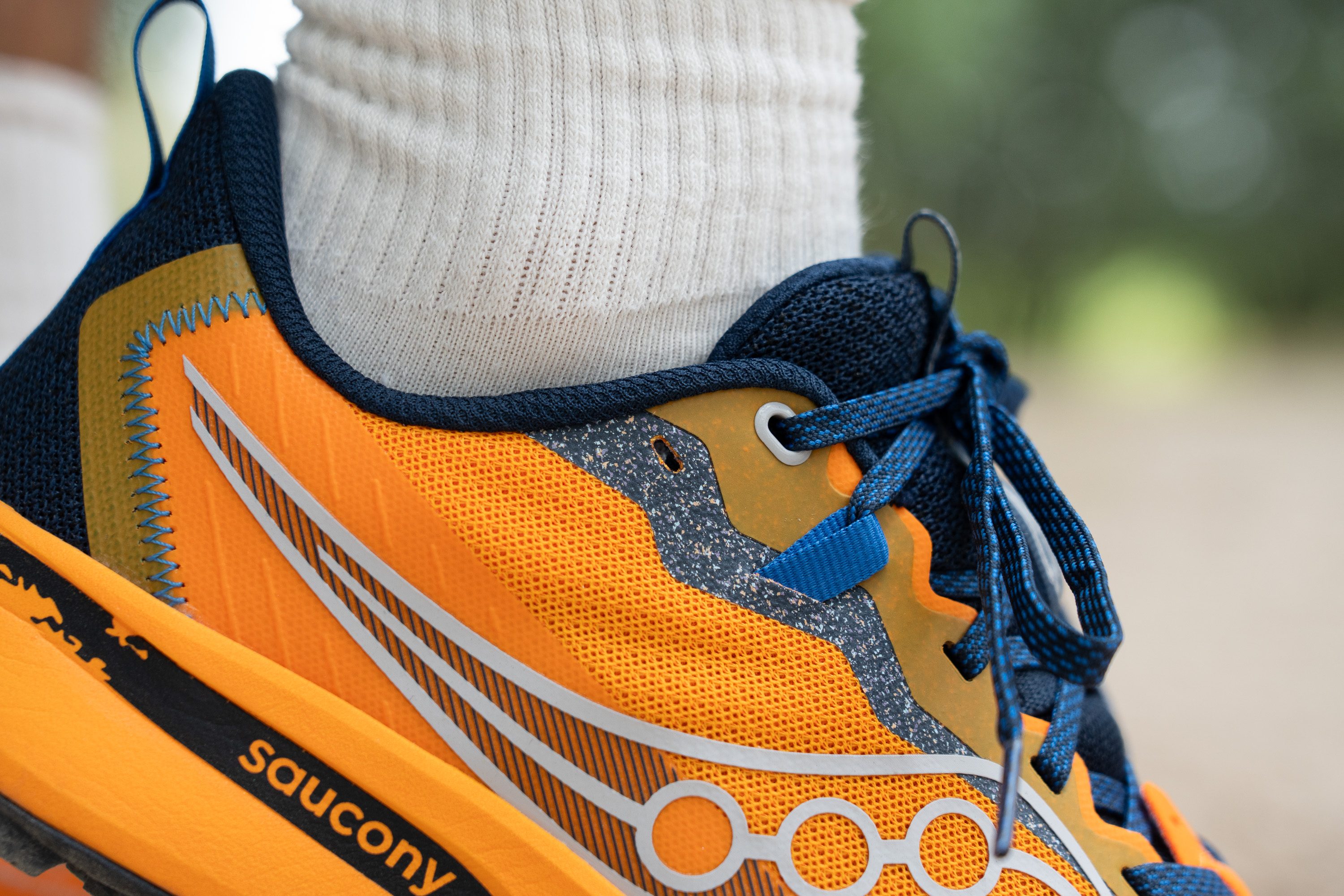
También descubrimos que las Peregrine 15 cuentan con un sistema de cordones simplificado en comparación con la versión 14. En esta actualización, Saucony utiliza solo un lazo de tela azul en cada lado para mejorar el ajuste. En la versión anterior, había dos de estos lazos en cada lado, lo que añadía más complejidad al diseño.
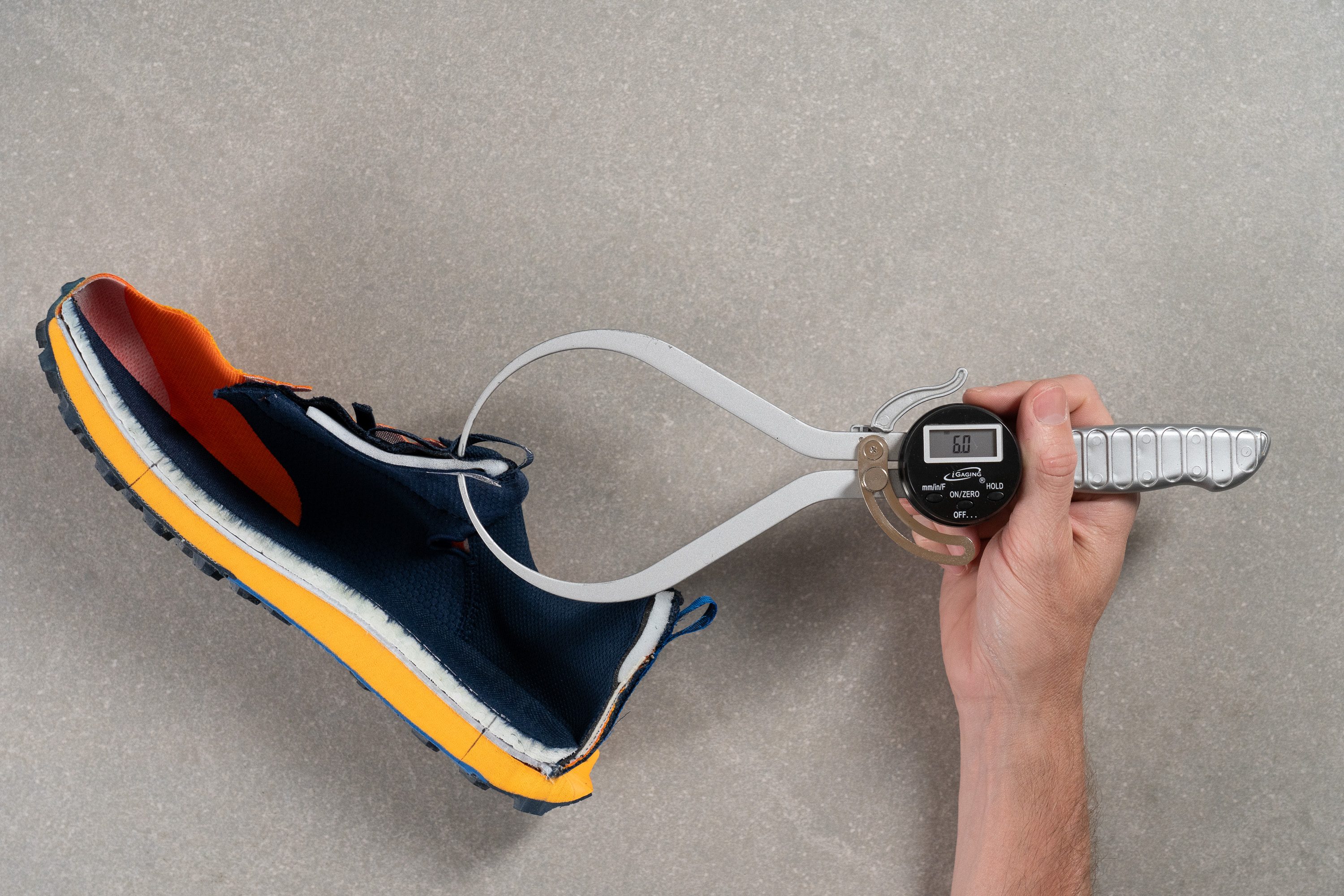
| Peregrine 15 | 6.0 mm |
| Media | 6.4 mm |
Lengüeta: tipo de refuerzo
La lengüeta está cosida a los lados, que es algo que siempre agradecemos en unas zapatillas de senderismo.
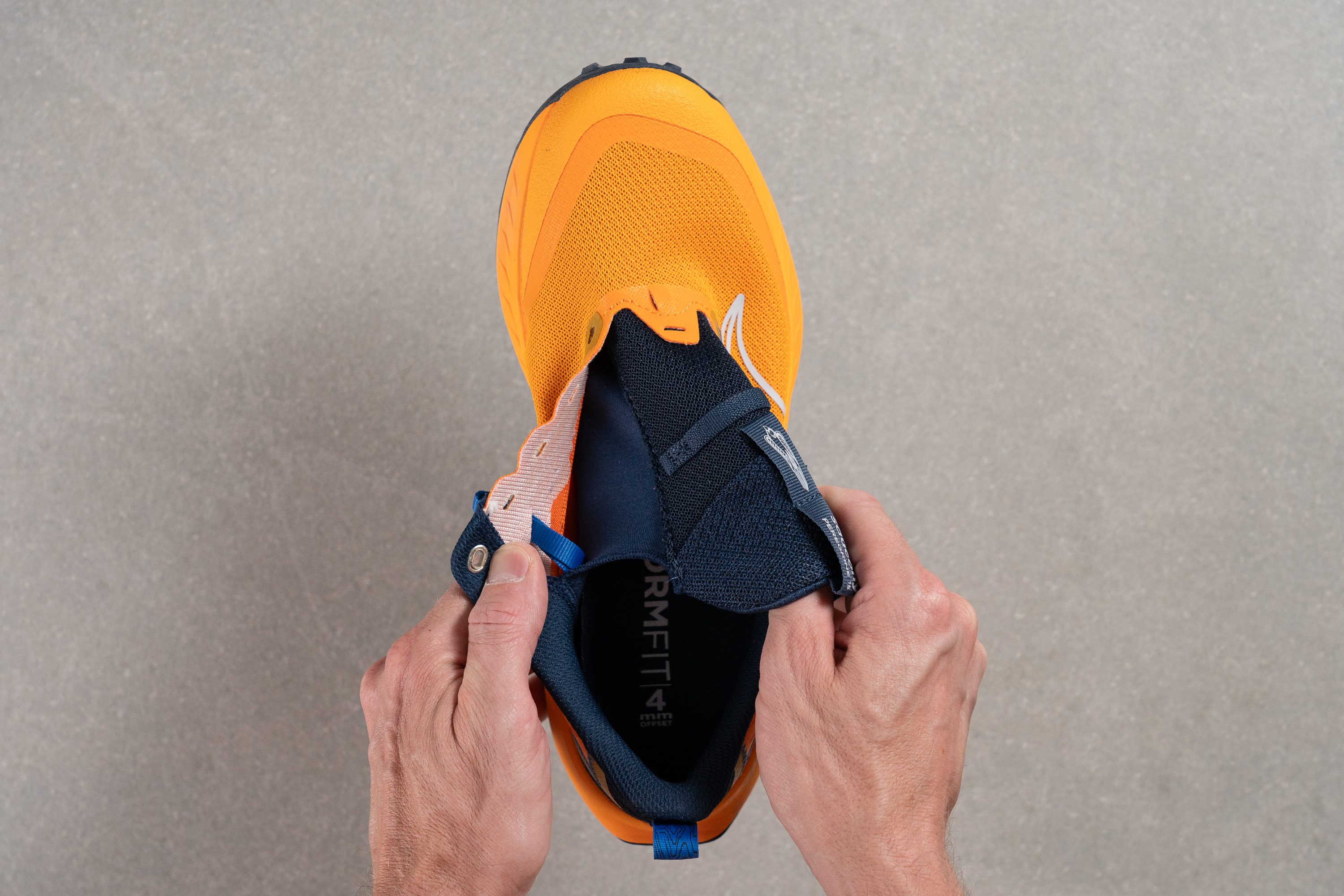
| Peregrine 15 | Ambos lados (semi) |
Precio
Una de las características destacadas de las Peregrine 15 es su precio razonable, que va de la mano con los de las zapatillas de entrenamiento diario para correr por asfalto más vendidas. Los modelos de trail suelen ser más caros, así que nos alegró mucho ver que esta versión no trajese un aumento de precio con ella.
| Peregrine 15 | $140 |
Tirador del talón
Tienen un tirador en el talón que es simple pero funcional, y que hace que las zapatillas tengan un aspecto más adecuado para el trail. Están reforzadas con costuras sólidas, y no nos esperamos que pierdan estructura con el uso constante.
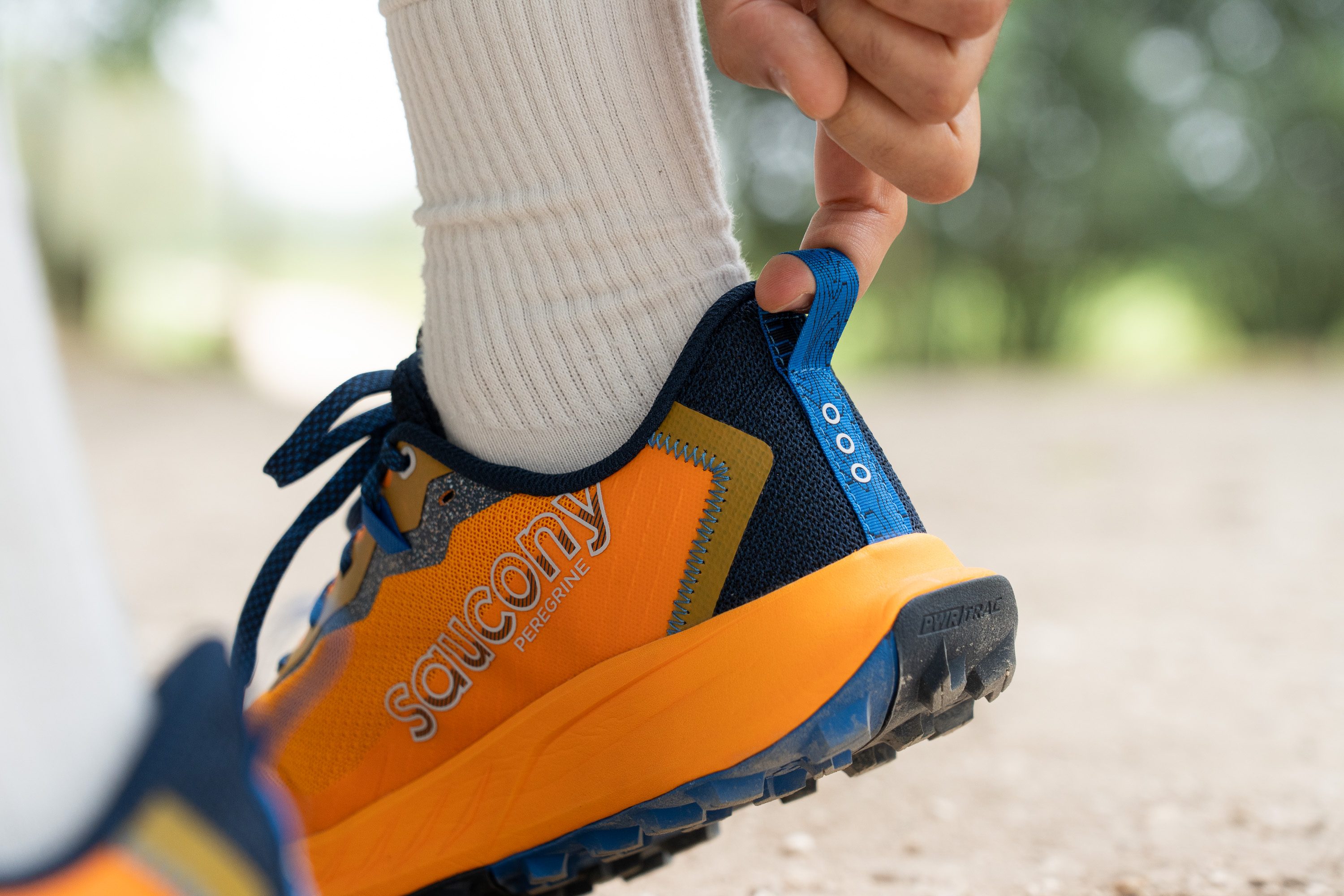
| Peregrine 15 | Tirador circular |

